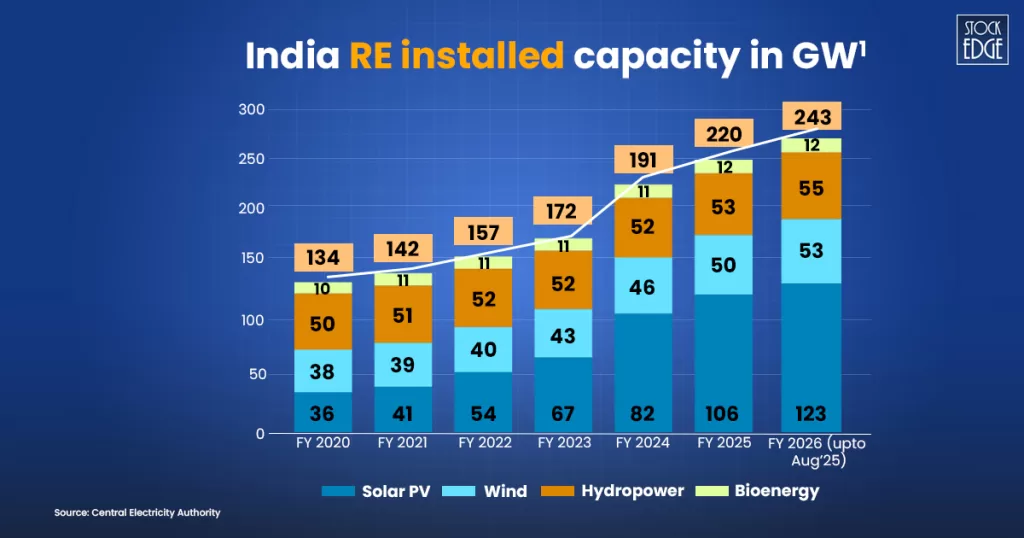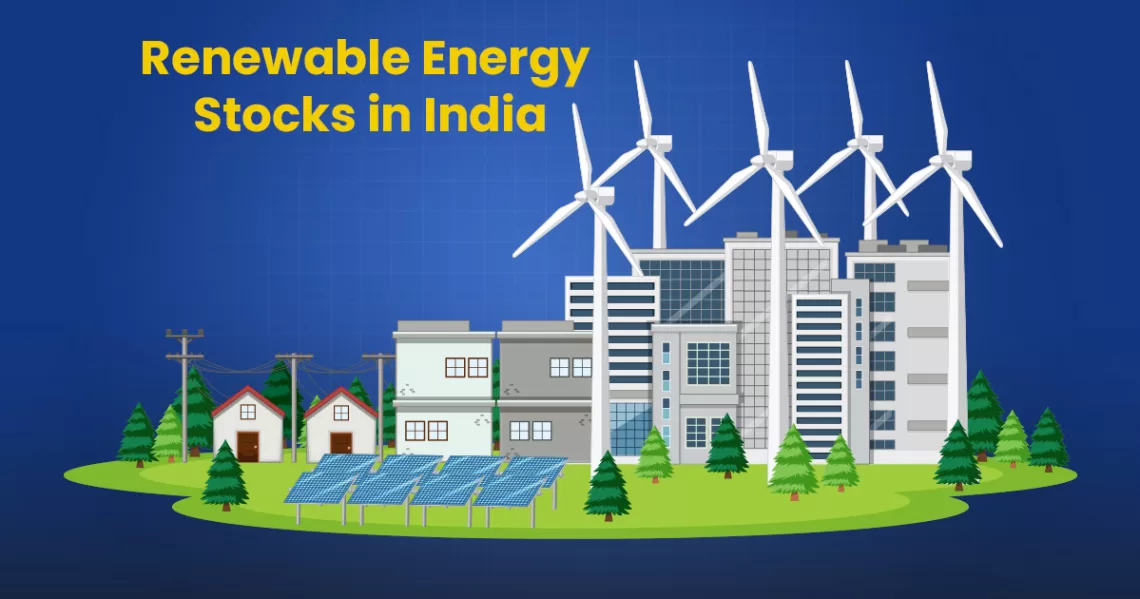Key Takeaways
- India’s clean-energy shift: The push toward solar, wind, and hydro power is growing rapidly as the country reduces dependence on fossil fuels and expands green capacity.
- Government policies strengthen industry growth: Supportive measures like subsidies, tax benefits, and long-term renewable energy targets provide a strong foundation for expansion across the sector.
- Diverse business models: From large utilities expanding renewable portfolios to specialised players like Borosil Renewables, the sector offers varied investment opportunities in renewable energy stocks.
- Financial performance: Despite strong sector momentum, tracking fundamentals like debt, cash flows, profitability, and capacity addition remains essential for long-term evaluation.
- Portfolio diversification: With rising renewable energy needs and structural clean-energy adoption, renewable energy stocks can act as sustainable long-term wealth creators.
Renewable energy is gaining importance as the world becomes increasingly conscious of the urgent need to address climate change and reduce dependence on non-renewable energy sources. This has resulted in the development and implementation of various forms of renewable energy solutions such as wind, solar, hydroelectric, and geothermal power on a global scale.
With the growing demand for renewable energy, there has been a surge in the number of renewable energy stocks traded at the National Stock Exchange (NSE) and Bombay Stock Exchange (BSE) in India. These stocks have the potential to drive the economy towards a more sustainable future and support the transition towards a low-carbon future. With high potential comes the need of high amount of analysis of stock market.
With the growing demand for renewable energy, there has been a surge in the number of renewable energy stocks & EV stocks traded at the National Stock Exchange (NSE) and Bombay Stock Exchange (BSE) in India. These stocks have the potential to drive the economy towards a more sustainable future and support the transition towards a low-carbon future.
What is Renewable Energy?
Renewable energy is energy produced from natural, renewable resources that replenish themselves over time, such as sunlight, wind, rain, geothermal heat, and tides. Renewable energy technologies absorb and transform energy from these resources into usable energy, such as electricity or heat.
Renewable energy is seen as sustainable since it is obtained from constantly renewed resources, so it never runs out. Nonrenewable resources, on the other hand, such as fossil fuels (such as oil, natural gas, and coal ), are finite and will ultimately deplete.
Overview of Renewable Energy in India
India’s renewable energy sector is expanding rapidly, supported by strong policy momentum and ambitious national goals. As per the Ministry of New and Renewable Energy, India added 220 GW of renewable capacity in FY25 and is now aiming to scale up to 500 GW of non-fossil-fuel power generation by 2030.

The government has set ambitious goals for implementing renewable energy. In addition to these objectives, the government has adopted a variety of legislative incentives to promote renewable energy development, such as feed-in tariffs, tax breaks, and subsidies for renewable energy projects.
India has drawn tremendous investment in renewable energy in recent years, with domestic and foreign corporations engaging in renewable energy projects. This investment will continue in the following years, given the country’s increasing energy consumption, favorable policy climate, and robust economic development. This will benefit the Renewable energy stocks in India as a whole, but it is also important to search for individual stocks and analyze them accordingly.
Importance of Renewable Energy Stocks
- Diversification: Renewable energy stocks allow investors to diversify their portfolios. This is especially important in a market like India, where fossil fuels have historically dominated the energy sector. Investing in renewable energy stocks can help investors reduce their risk and volatility exposure in the traditional energy market.
- Environmental advantages: Renewable energy stocks in India allow investors to support companies working to make the world more sustainable and environmentally pleasant. Investing in renewable energy stocks can assist in driving a low-carbon economy and mitigating the effects of climate change.
- Government support: To encourage the growth of renewable energy, the Indian government has introduced a variety of policy incentives, including subsidies, tax exemptions, and other financial incentives. This assistance has contributed to the creation of a favorable climate for renewable energy enterprises, as well as to the sector’s growth. This will directly benefit renewable energy stocks.
Criteria for selecting the Top Renewable Energy Stocks
Financial performance
While examining renewable energy stocks, investors should consider many critical financial metrics. Here are some of the most factors financial aspects to consider:
- Revenue: Revenue is a significant measure of the financial performance of renewable energy stocks. Investors should search for organizations with a history of steady revenue growth, which indicates a high demand for the company’s products and services.
- Gross Margin: Gross margin is a vital indication of a company’s profitability since it gauges the difference between Revenue and COGS. Therefore, greater gross margins are typically a good indicator since they imply that the company can earn more profit per unit of revenue.
- Debt-to-Equity Ratio: The debt-to-equity ratio is a financial leverage indicator computed by dividing a renewable energy stock’s total debt by its equity. A more significant debt-to-equity percentage signifies that the company depends more heavily on debt to finance its operations, which can be a symptom of heightened risk.
- Cash Flow: A company’s ability to create cash from its activities is measured by its cash flow. Investors should search for businesses with positive cash flow since it suggests that the company can support its operations and investments without relying on outside financing.
Growth potential
India’s renewable energy sector is quickly expanding, with tremendous room for expansion in the future. Consequently, renewable energy stocks in India can create substantial returns for investors who can spot and capitalize on the correct opportunities. And to encourage the growth of renewable energy, the Indian government has introduced a variety of policy incentives, including subsidies, tax exemptions, and other financial incentives. This assistance has contributed to the creation of a favorable climate for renewable energy enterprises, as well as to the sector’s growth, which will directly benefit renewable energy stocks. Identifying the top stocks in this sector might be daunting; therefore, it is extremely important for an investor to do effective research with a stock market analysis tool to make more informed decisions.
Top Renewable Energy stocks in India
NTPC Ltd. (National Thermal Power Company)
Company Overview
NTPC (National Thermal Power Company) Ltd, with its subsidiaries, partners, and joint ventures, is principally involved in generating and selling bulk power to state power utilities. The group’s other businesses include consultation, project management and supervision, energy trading, oil and gas exploration, and coal mining. And it wants to expand its non-fossil fuel asset concentration from 7% of total capacity to 30% by 2032. As of today’s date, this is NTPC share price
Financial performance
- Consolidated sales were Rs 451 billion in Q3FY25, up 5.2% year on year, while EBITDA grew around 5% YoY to Rs 146 billion. The reported consolidated PAT was Rs 50.6 billion (-1.8% YoY) during the quarter.
- On a full-year basis, consolidated PAT stood at Rs 239.5 billion (+12% YoY), despite modest growth in total income to Rs 1,908.6 billion (+5% YoY).
- Incentives for the year were not separately disclosed, though generation-based incentives and efficiency gains continued to support margins. As a result, profit from subsidiaries rose to Rs 41.4 billion in FY25 (from Rs 39.0 billion in FY24).
- In contrast, NTPC’s share of JV earnings increased to Rs 22.1 billion in FY25 (from Rs 16.4 billion in FY24), mainly driven by improved performance from key joint ventures and normalization of earlier accounting adjustments.
- Dividend income from subsidiaries and joint ventures was not separately disclosed for FY25.
Tata Power Company Ltd.
Company Overview
Tata Power Company Limited primarily engages in power generation, transmission, and distribution. It intends to generate all of its power from renewable sources. It also makes solar roofing and aims to construct 25,000 electric vehicle charging stations by 2028. In the future, the company hopes to achieve a clean and green portfolio of 80% by 2030 and 100% by 2045 and develop through low-carbon enterprises. As of today’s date, this is the Tata Power Company share price.
Tata Power Company is a part of Nifty Next 50 Indices.
Financial performance
- Tata Power delivered a strong financial performance in FY25, reflecting operational efficiency, diversification, and continued progress on its clean energy transition. The company’s consolidated revenue rose by 5% year-on-year to ₹64,446 crore
- Consolidated EBITDA increased by 14% to ₹14,468 crore, while profit after tax grew by 12% to ₹4,775 crore, supported by better margins and disciplined cost management, though partially offset by lower coal JV profits due to softer international prices
- The transmission and distribution business remained Tata Power’s largest contributor, generating ₹39,121 crore in revenue—an 8% increase over FY24 and ₹3,128 crore in segment results; up 29%.
- The renewables segment recorded ₹9,876 crore in revenue, a slight decline from the previous year, but segment profits rose sharply by 34% to ₹2,881 crore due to higher efficiency and asset availability
- The net debt-to-EBITDA ratio remained around 3.7×, consistent with the company’s medium-term target of keeping it below 3.5×.
Borosil Renewables Ltd.
Company Overview
Borosil Renewables manufactures ultra-clear patterned glass and low-iron solar glass for use in photovoltaic panels, absorber plate collectors, and green homes. In addition, BRL manufactures low-iron solar glass for use in photovoltaic panels.
They are the country’s first and only maker of solar glasses. The Company’s thinner, completely tempered solar glass (2mm and 2.5mm) fills a niche market for glass modules. As of today’s date, this is Borosil Renewables share price
Financial performance
- Borosil Renewables faced a challenging year in FY 25, marked by declining profitability; despite revenue growth, mainly due to heightened competition from low-cost imports, falling solar glass prices, and higher input costs.
- The company’s consolidated revenue from operations stood at ₹ 1,575 crore, compared to ₹ 1,477 crore in FY 24 — a growth of about 6.6 % YoY.
- However, EBITDA fell sharply from ₹ 365 crore in FY 24 to ₹ 177 crore in FY 25, reflecting margin pressure across both its Indian and European operations. Consequently, profit after tax (PAT) declined to ₹ 45 crore in FY 25 from ₹ 160 crore in FY 24, representing a 72 % YoY decline.
- The company’s net debt increased to ₹ 760 crore in FY 25 from ₹ 645 crore in FY 24, primarily due to ongoing expansion projects and capacity upgrades. Despite this, the net-debt-to-equity ratio remained at a manageable 0.65×
KPI Green Energy Ltd.
Company overview
KPI supplies solar electricity to captive power producers (CPP) consumers as an independent power producer (IPP) as well as Procurement, Engineering, and Construction (EPC) services. The company’s whole operation is based in Bharuch.
Today, the business has 100 MW of solar power installed capacity within the IPP sector and 100 MW+ of EPC/CPP projects. In Gujarat, the company offers solar energy through third-party sales. It builds and manages grid-connected IPP solar power plants using the’ Solarism’ brand. Using Power Purchase Agreements, the company provides power generated by solar power facilities to businesses (PPA). As of today’s date, this is KPI Green Energy share price.
Financial performance
- KPI Green Energy Limited (KPIE) continued its strong growth trajectory in FY25, delivering record revenue and profit performance supported by robust execution in both its IPP (Independent Power Producer) and CPP (Captive Power Producer) segments.
- The company reported consolidated revenue from operations of ₹1,073.1 crore, up 24% year-on-year from ₹866.7 crore in FY24. This growth was driven by higher solar power generation, strong demand from captive clients, and continued expansion of installed capacity.
- EBITDA stood at ₹459.2 crore in FY25, marking a 30% increase over ₹352.2 crore in FY24, with an EBITDA margin of 42.8%. The profit after tax (PAT) for the year rose to ₹225.8 crore, compared to ₹172.2 crore in FY24 — a 31% increase year-on-year. The improvement was supported by higher generation income, increased project sales, and disciplined cost control.
- Net debt stood at ₹ 1,084 crore at the end of FY25, compared to ₹ 853 crore in FY24, reflecting higher capital expenditure for project development. Despite this, KPIE’s net debt-to-equity ratio remained moderate at 1.2×, supported by robust operating cash flows and retained earnings.
- Cash accruals and internal generation comfortably covered interest obligations, maintaining a healthy interest coverage ratio of 4.7× in FY25.
Conclusion
Finally, the renewable energy industry in India is continuously increasing and evolving, providing an excellent opportunity for investors interested in environmentally sensitive and sustainable investments. The renewable energy sector is predicted to develop rapidly in the following years, thanks to the Indian government’s commitment to decreasing greenhouse gas emissions and attaining a target of 450 GW of renewable energy capacity by 2030.
Investing in renewable energy stocks can allow you to participate in the sector’s growth while helping create a greener, cleaner, and more sustainable future. Yet, because the renewable energy business may be very competitive and unpredictable, investors must exercise caution and thoroughly analyze individual companies.
The company’s financial health, portfolio of renewable energy projects, track record of project execution, and strategic plans for development and expansion are all critical variables to examine when analyzing renewable energy stocks. Furthermore, investors should evaluate the regulatory framework and government policies that may influence the renewable energy market.
Overall, renewable energy stocks are a valuable addition to an investing portfolio, allowing participation in a sustainable and expanding industry while earning significant returns.
Note: NTPC and Tata Power Ltd have a high debt-to-equity ratio, which means they have a high portion of debt in their balance sheet, and the reason is that they are investing heavily in Fixed Assets, which is justified by the cash flow statement, ie. Cash flow from investing and financing activity. And both the company is in a capital-intensive business, so they finance their capex with the debt and internal accruals to maintain a healthy return on capital for the investors, which is decided by the management.
However, as with such companies, various risks are associated, which can impact the Company’s performance.
We would advise consulting your SEBI-registered investor before investing in any of these.
Until then, keep an eye out for the next blog on “Stock Insights.” Also, please share it with your friends and family.
Happy Investing!
Frequently Asked Questions (FAQs)
1. Which segments within renewable energy are growing the fastest?
Solar power leads the growth, followed by wind and hybrid energy. Manufacturing areas like solar modules, inverters, and glass are also expanding quickly.
2. How can I analyse renewable energy stocks on StockEdge?
You can track fundamentals, compare peers, study capacity growth, check debt levels, monitor corporate announcements, and follow themes like “Solar Energy” directly within StockEdge.












